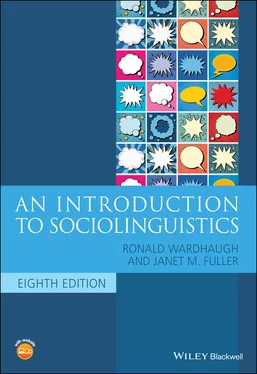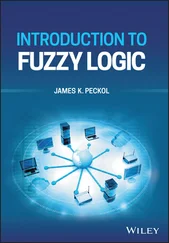This process of stereotypes of the speech of particular social groups is also addressed in recent work on raciolinguistics(Alim et al. 2016; Rosa 2016; Rosa and Flores 2017). This research investigates how connections are made between ways of speaking and racial categories, and how the ways of speaking associated with stigmatized social categories are devalued. This process involves assumptions and ideologies about language and language users. Rosa and Flores (2017) offer an example of how in the 2016 presidential election, Julian Castro, a Latinx man, was portrayed as linguistically deficient because of his (purported) lack of Spanish fluency, while Tim Kaine, a White man, was praised for his ability to speak (some) Spanish as a second language. Even assuming that there was any truth to the accusation of meager Spanish skills on Castro’s part (see Rey Agudo 2019 for a discussion of this), the fact that both men spoke English fluently and also (at least some) Spanish was seen as a deficit in one case and an accomplishment in the other. This evaluation is the result of assumptions about indexicality – speaking Spanish indexes a Latinx identity – and also ideologies about the Spanish of immigrant background English speakers being a liability, and the Spanish of White mainstream English speakers being an achievement. Many of the critics of Castro’s Spanish – and the Spanish of Latinxs in the US more generally – are not themselves Spanish speakers; but as White, mainstream English speakers, their assumptions about the linguistic deficiency of Latinx is taken seriously, and are part of the perpetuation of raciolinguistic stereotypes (Rosa and Flores 2017, 628–629). As this example, as well as the Mock White Girl example, shows, indexicality is an ideological process.
Scholars have also discussed different types of indexical meaning, a summary of which is provided by Johnstone et al. (2006). What is called the first order of indexicality refers to features below the level of consciousness. An example of this is regional features; while for outsiders these mark speakers as being from a certain region, for non‐mobile speakers they are not noticed because ‘everyone speaks that way’ (Johnstone et al. 2006, 82). Second‐order indexicality is when these features are recognized as belonging to certain ways of speaking, i.e., speakers can use them stylistically to index belonging or to distance themselves from the social group these ways of speaking are associated with. Third‐order indexicality correlates with what Labov (1972) called stereotypes; in this case linguistic features are widely recognized as belonging to particular varieties, and are used to construct identities of (stereotypical) members of the social group.
The process through which meaning becomes attached to linguistic form is called enregisterment(Agha 2006). This concept shifts the focus from a static description of what has been called a register(a way of speaking which is evocative of a particular context) to the dynamic process through which this association emerges. Johnstone (2016) discusses this process in terms of association of particular linguistic features and place, noting:
‘Enregister’ is a multi‐place predicate. A (a linguistic form or some other potentially meaningful act) is enregistered with B (a register) by C (an agent) in terms of D (an ideological schema) because of E (an interactional exigency in which calling attention to the enregisterment of or enregistering one or more forms serves some rhetorical function) and F (a sociohistorical exigency that gives rise to metapragmatic practices). (Johnstone 2016, 633–634)
To give just one example from Johnstone’s article, a participant in an online forum about Pittsburghese said, ‘I gotta tell yunz I think the way we talk is neat.’ Yunz is a form heard in Pittsburgh which means ‘you‐plural.’ This linguistic form (A) is enregistered with Pittsburghese (B) by this forum participation (C) in terms of the ideology of local belonging (D) evoked in the context of the online discussion which evaluates the regional dialect (E) which has been stigmatized but is also a matter of pride for its speakers (F).
Another relevant concept in the study of such stylistic performances is that of entextualization(Bauman and Briggs 1990). In this process, a chunk of discourse, or a text, becomes bounded, recognizable and replicable, and can thus be taken out of context and used in other discursive contexts. This is also discussed in terms of intertextuality, which is the use of text from one source to shape the meaning of another text (Fairclough 1992).
Leppänen et al. (2014) discuss this as a key resource for the construction of identities in social media, a point also discussed by Akkaya (2014). Language users on social media use chunks of text from other contexts to create new meanings. A prime example of this is the use of memes (Huntington 2013). In this multimodal form of communication, pictures and videos are circulated with changes in text which construct ideological stances (Davison 2012). In many cases, a particular photo is always used with the same text. For example, in the ‘Am I a joke to you’ meme shown in Figure 2.1, there is a picture of a serious‐looking man with the text Am I a joke to you? at the bottom. This meme is used to humorously scold someone for not taking someone or something seriously enough. We see one use of this meme in Figure 2.1. Here, the meaning is clearly that the boy is lying and is ‘talking to’ (which in this context means flirting with, dating, etc.) other girls, but uses ‘swearing on his grandma’ to imply sincerity – and grandma in heaven accuses him of not taking her seriously. In this case, the meme can be interpreted without knowledge of past memes, as the text at the bottom makes the meaning explicit.
However, in some cases the picture in a meme is so well known it is used without text; in this case knowing the text which usually goes with the picture is necessary to interpret the meme. An example of this with this same meme is given in Figure 2.2. Here the joke is about the lack of subtitles, with in this case the subtitles being the entity which is complaining about not being taken seriously.
In some cases, pictures from popular media, such as films, are used in such a way that the meaning is linked to the original text, which is not given in the meme; thus the meaning is derived from knowledge of the original source. An example of how meaning is tied to the entextualization of the picture can be found in the ‘Is this a pigeon?’ meme ( https://knowyourmeme.com/memes/is‐this‐a‐pigeon). This picture, taken from a Japanese anime TV series, shows a man holding up one hand and gesturing toward a butterfly; the original text was Is this a pigeon? The answer to this question is clearly no, and from this the meaning of this meme to indicate misunderstanding and confusion is derived. When other text is superimposed upon this picture, the same relationship between what the man represents and what the butterfly represents holds: the man is misidentifying the butterfly, and the answer to the question at the bottom is ‘no.’ For example, in one meme the man is labeled depressed White guys and the butterfly White supremacist propaganda and the question at the bottom is, Is this a sense of belonging? The message here is that while depressed White guys may think White supremacism will give them a sense of belonging, it will (or perhaps should) not.

Figure 2.1 ‘Am I a joke to you’ meme.
Читать дальше





![Andrew Radford - Linguistics An Introduction [Second Edition]](/books/397851/andrew-radford-linguistics-an-introduction-second-thumb.webp)







